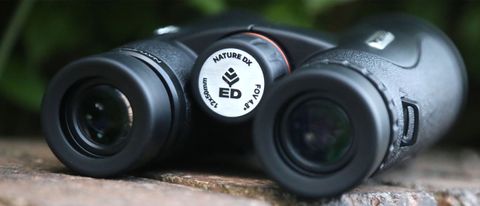Space Verdict
The Celestron Nature DX ED 12x50 are some of the finest handheld binoculars for stargazing, wildlife observations and more. Their key in flexibility is their use of high-end extra-low dispersion (ED) objective lenses, which help create sharp, bright, and aberration-free images within a compact and portable design.
Pros
- +
ED objective lenses
- +
Sharp, bright images
- +
Compact and portable
- +
Sturdy protective pouch
Cons
- -
Expensive pair of binoculars
- -
Average eyecups
Why you can trust Space.com
Are you ready to invest in a pair of the best binoculars that will last a lifetime? With 12x magnification and 50 mm objective lenses, the Nature DX ED 12x50 are among the most versatile and solid binoculars and are ideal for travel, safari and general astronomy.
Magnification: 12x
Objective lens diameter: 50mm
Angular field of view: 4.8 degrees
Eye relief: 0.-56-inch/14.3mm
Weight: 28.4oz/806g
You'll get a high-end experience whenever you use them, not only because of the solid and expensive-looking build quality but also because they use a special glass. Extra-Low Dispersion (ED) glass keeps views bright, sharp and with accurate colors throughout the 4.8-degree field of view. Add a handy neck strap, some un-losable objective lens caps and a nice padded shoulder bag and the Nature DX ED 12x50 is destined to impress for a long time.
Celestron Nature DX ED 12x50 binoculars: Design
- Extra-Low Dispersion (ED) glass
- BaK-4 glass roof-prism optics
- Nitrogen-filled to prevent internal fogging
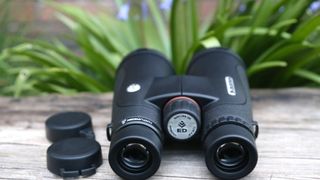
With 50mm objective lenses, the Nature DX ED 12x50 are prime candidates for use at night, though that 12x magnification is a touch more than you'll find on most binoculars touted for astronomy. That makes them just as ideal for wildlife, particularly since they also have a close focus of just 2m/6.5 ft.
Roof prism binoculars like the Nature DX ED 12x50 are all about saving space, while their porro prism rivals are mostly about value for money. Is Nature DX ED 12x50 worth the extra spend? The considerable extra outlay gets you much better optics than you will find at the entry-level, that's always the case with binoculars. On the Nature DX ED 12x50, you get Celestron's ED glass. ED stands for extra-low dispersion, used on the large 50 mm objective lenses at the end of the tubes.
When reading about binoculars, you'll hear a lot about 'multi-coatings,' which is pretty meaningless. It generally refers to glass coatings allowing more light transmission and, therefore, brighter images. Still, it's long become standard marketing-speak, and you'll now do well to find binoculars that don't claim to have some kind of multi-coatings, even at the extreme budget end of the market. ED glass is a bit different.
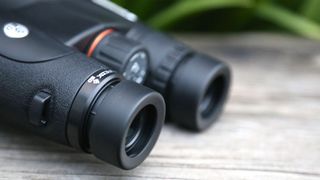
As well as being designed to deliver brighter images, ED glass is there to eliminate something called chromatic aberration. Also known as color fringing, this refers to an optical distortion within lenses that fails to accurately focus different wavelengths of light — each representing a different color which causes a slight blur. It is particularly evident during low light, dusk and dawn, and when looking at bright objects like the Moon, which can be fringed with yellow and purple.
Objective lens caps
Rainguard for eyecups
Shoulder strap
Padded carry case
Lens cleaning cloth
The ED glass inside the Nature DX ED 12x50 is an attempt to correct such chromatic aberrations by not allowing the different colors to disperse and therefore focusing the wavelengths of light on a single point. While the objective lenses get ED glass, the Nature DX ED 12x50s' roof prisms use top-draw BaK-4 glass and use phase coatings to transmit more light. Cue a sharper, more detailed image. The Nature DX ED 12x50 tubes are also filled with dry nitrogen gas to help prevent any internal fogging.
Celestron Nature DX ED 12x50 binoculars: Performance
- Excellent optics
- No chromatic aberration
- 2m/6.5ft focus
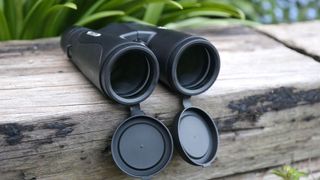
Roof prism binoculars like the Nature DX ED 12x50 exist because they're more compact and easy to travel with than porro prism binoculars, and not because they transmit more light. They don't — which is why the phase-coated BaK-4 glass roof prisms and the ED make a big difference.
Given how lightweight and compact the Nature DX ED 12x50 are (they weigh 28.4oz/806g and measure 163x135x61mm/6.4x5.3x2.4-inches) — we were able to take them out for tests at several events.
ED glass works really well. Its 4.8-degree field of view constitutes an incredible close-up when viewing objects in the distance, with a trip to see some motor racing heralding bright and sharp views even in the distance. That applies to dusk, though it's at night that we were most impressed by the Nature DX ED 12x50.
Pointing them immediately at some of the brightest stars and objects in the night sky, we failed to detect any traces of yellow and purple color fringing around while observing super-bright Sirius and a First Quarter Moon. Meanwhile, the dozens of stars within the Pleiades star cluster looked uniformly sharp, almost to the very edge of the field of view.
The Nature DX ED 12x50s' 2m/6.5ft close focus was most helpful in our backyard, where we could observe wood pigeons and sparrows from close range. The views are always bright with plenty of contrast.
Something we did have a slight issue with is the focusing wheel. Although it's easy enough to use, you do have to take quite a journey from one end of the scale to the other, which makes it slightly long-winded to refocus the binoculars for an object closer to you after studying something in the distance. We're also not convinced by the Nature DX ED 12x50's eyecups, which don't give much eye relief and seem something of a weak point.
Celestron Nature DX ED 12x50 binoculars: Functionality
- Grippy rubber armor
- Objective lens caps are easy to lose
- Lack of eye relief
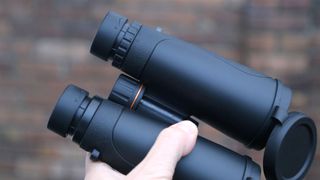
The Nature DX ED 12x50 binoculars have an excellent build quality and are terrifically easy to use. There are some nice design flourishes, such as textured side panels where your fingers will rest and around eyepieces. The latter is useful when holding binoculars high above your head while stargazing. There are no textured thumb rests towards the end of the tubes — where you should hold binoculars when looking at objects closer to the horizon.
Overall, the build quality is excellent, with the Nature DX ED 12x50 wearing a tough and waterproof rubber armor. The objective lens caps are hard to lose as they are attached, but you can remove them. The eyecups are attached to the neck strap, which is of decent quality, like the padded case with the Nature DX ED 12x50. We like its slightly padded design and the fact that it has a small pocket.
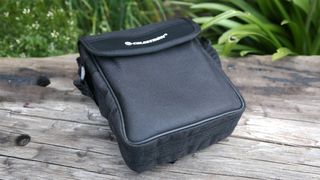
We found operating the Nature DX ED 12x50 easy, with the diopter adjustment and center focus wheels feeling exceptionally smooth but with enough resistance to stop any accidents knocking them out of focus. Ditto the twist-up plastic eyecups, which have two click-in positions, though they are of distinctly average quality. The two tubes of the Nature DX ED 12x50 are attached using a hinge in the center around that focus wheel, which again has an excellent combination of smoothness and resistance so you can set and retain your interpupillary distance accurately for an observing session and not have to re-calibrate anything.
Should you buy the Celestron Nature DX ED 12x50 binoculars?
If you're after an impressive pair of binoculars to keep with you for a very long time, then the Nature DX ED 12x50 makes a compelling argument. Boasting excellent build quality and top drawer optics, you can use the Celestron Nature DX ED for all scenarios, from wildlife safari to stargazing. The slight increase in magnification compared to many astronomy-centric binoculars doesn't make that much difference when observing the night sky. Still, it does prove very useful for wildlife and sports events.
Close focus is also of actual practical use when using the Nature DX ED 12x50 for birdwatching. Yes, they're expensive, but the Nature DX ED 12x50 binoculars are about as dependable a pair of all-around binoculars as you will come across at this mid-range price.
If the Celestron Nature DX ED 12x50 binoculars aren't for you:
An excellent alternative to the Nature DX ED 12x50 if your aim is astronomy and you want to save money is the Celestron UpClose G2 10x50 porro prism binoculars, which are affordable yet present only minor image distortion.
If you want to spend more and want perfectly image-stabilized binoculars, then go for the Canon 10x42L IS WP, which will give you super-steady stargazing through the same L glass found in Canon's finest camera lenses. A slightly smaller alternative to the Nature DX ED 12x50 binoculars are the Celestron TrailSeeker 8x42 binocular which don't include ED glass but do boast similarly superb build quality.
Join our Space Forums to keep talking space on the latest missions, night sky and more! And if you have a news tip, correction or comment, let us know at: community@space.com.

Jamie is an experienced science, technology and travel journalist and stargazer who writes about exploring the night sky, solar and lunar eclipses, moon-gazing, astro-travel, astronomy and space exploration. He is the editor of WhenIsTheNextEclipse.com and author of A Stargazing Program For Beginners, and is a senior contributor at Forbes. His special skill is turning tech-babble into plain English.
